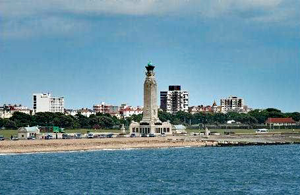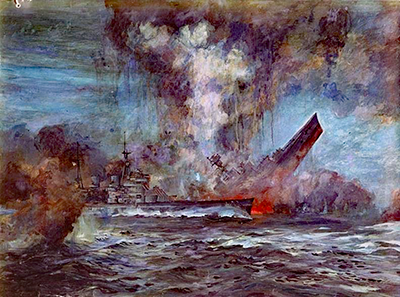Second World War - Lynsted Memorial Project
Arnold Edward TAYLOR (of Doddington)
b. 8th October 1908 P/JX 234946 Ordinary Seaman, Royal Navy |

Arnold was born on 8 October 1908 in Kingston upon Thames, Surrey, to Edward and Alice (known as May) Taylor. Arnold was one of six children (3 boys and 3 girls).
The family later lived in Westerham, Kent but by 1934 Arnold was a fruit farmer living at Little Frith, Doddington.
 When word first came to his parents about the loss of HMS Hood they at first believed that he was not on the ship at the time as he was recovering from a bout of German measles. Sadly, Arnold had just re-joined the Hood.
When word first came to his parents about the loss of HMS Hood they at first believed that he was not on the ship at the time as he was recovering from a bout of German measles. Sadly, Arnold had just re-joined the Hood.
Hood's last Battle
HMS Hood was the largest and most iconic British warship of its time.
On 22 May 1941 HMS Hood (in which Vice Admiral Holland had raised his flag only ten days previously) put to sea to search in the Denmark Strait for the German battleships Bismarck and Prinz Eugen. On 24 May, at 5:35 am, Bismarck was sighted and Hood altered course to intercept. At 5:53 am the ships opened fire and scored hits almost at once. At 6:00 am Hood was hit between the after funnel and the mainmast. There was a huge explosion and she sank within three minutes.
Of the ship's company of 1,418 men, there were just 3 survivors.
The loss of this iconic ship and so many men was a devastating blow felt throughout the country.
It was the largest death toll ever in any British warship. The equivalent to the destruction of three regiments of soldiers. It took less than 15 minutes. 71 of those lost were teenagers - 'boy seamen' aged 16 or 17. HMS Hood is the largest Royal Navy warship ever to have been lost in action.
The military implications were very serious. The Admiralty was concerned that losses of merchant ships to U boats were becoming overwhelming, and the presence of Bismarck could only add to the losses should she reach the convoys. With HMS Hood sunk, the situation became desperate, hence Churchill's famous signal to the fleet "Sink the Bismarck" which led directly to the pursuit and destruction of Bismarck three days later with the loss of 1,995 of her crew of 2,200.
| Sevenoaks Chronicle and Kentish Advertiser of 6th June 1941 |
| LOST IN H.M.S. HOOD Amongst those announced as having been lost in H.M.S. Hood appears the name of Arnold Edward Taylor, R.N.V.R., of Little Frith Farm, Doddington, son of the late Mr E.A. Taylor and Mrs Taylor, of The Mount, Westerham. It will be recalled that another son of Mr and Mrs Taylor, Capt. A.H. Taylor (who formerly commanded the Westerham Territorials) was awarded the M.C. last July. |
Arnold is remembered on the Doddington and Newnham and Westerham Memorials. Also on the Portsmouth Naval Memorial, Panel 51, Column 2.
All of those lost are memorialised at the Hood Chapel, Church of St John the Baptist, Boldre, Hampshire. The officer in overall command Vice Admiral Lancelot Holland, who was amongst those lost on the Hood, used to worship in St John's Church Boldre Church with his family. After the war, his widow Phyllis Holland arranged for a memorial to be established at Boldre where an annual service of commemoration has been held ever since. In 2015 the Hood's ship's bell was recovered from the seabed and now sits in the chapel.
 Painting by J.C. Schmitz-Westerholt, depicting Hood's loss during her engagement with the German battleship Bismarck on 24 May 1941. HMS Prince of Wales is in the foreground.
Painting by J.C. Schmitz-Westerholt, depicting Hood's loss during her engagement with the German battleship Bismarck on 24 May 1941. HMS Prince of Wales is in the foreground.

